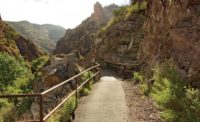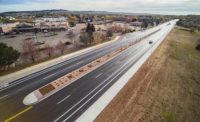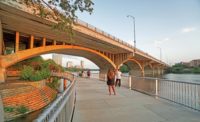Catwalk Trail Reconstruction
Glenwood, N.M.
Region ENR Southwest
Small Project (Under $10 Million)
Project Team
Owner/Developer: Federal Highway Administration, Central Federal Lands Highway Division
Design Firm: Bohannan Huston Inc.
General Contractor: AUI Inc.
Civil/Structural Engineer: Bohannan Huston
Geotechnical Engineer: NV5
Subcontractors: Saguaro GeoServices Inc.; Kimo Constructors Inc.; Franklin Drilling & Blasting; Southwest Concrete & Paving Inc.
Rebuilding a trail that threaded through a narrow canyon in a remote section of Gila National Forest posed numerous challenges and required seat-of-the-pants engineering. Natural events precipitated the project. A 2012 wildfire, the largest in New Mexico history, charred 297,000 acres, leaving the area more vulnerable to flooding. The following year, a heavy rainstorm flooded Whitewater Canyon, destroying the historic catwalk.
The parameters of the trail’s rebuild included the design and construction of three steel bridges along with 700 ft of suspended catwalk in the slot canyon. Workers restored primitive trails leading to the bridges, removed creek obstructions and flood-damaged structures, and preserved historical and archaeological elements.
The rock faces of the angulating canyon walls, with their pockets and overhangs, presented spatial puzzles. In addition, the trail’s vertical grade had to comply with accessibility guidelines, while its horizontal positioning had to keep the trail close to the canyon walls to minimize material used and the structure’s visual impact.
Due to the complex facets of the slot canyon walls, the project team used light detection and ranging (LiDAR) scanning, supplemented by a conventional ground survey, to accurately capture every nook and cranny of the canyon in a dense 3D mesh made up of millions of survey points. According to the construction team, mapping the canyon was critical to the project’s success because it allowed designers to locate with pinpoint accuracy where the support beams should be placed in the canyon walls and thereby minimize potential construction delays.
Scanning, surveying and modeling also provided the necessary level of accurate data to design and establish the height of the catwalk above the creek floor to minimize the risk of future flood damage. Site conditions led to a unique solution on marking beam placements: driving rebar into the canyon walls and bending it to match the required bearings.
Large boulders had to be removed in order to transport excavators, loaders, forklifts and man lifts to the site. To avoid the hazards associated with scaffolding and temporary ladders, the majority of the catwalk was constructed using man lifts. During the construction phase, from January through May, water levels in the canyon were typically at 1 to 2 ft, adding a bit more effort to the workers’ hike to the jobsite.
With the nearest source for aggregate materials over 60 miles away, it was critical to minimize import needs. As a result, gabion baskets and rip rap used for erosion control were constructed using onsite materials.
Scheduling was a concern, as the trail serves as the main economic draw for the tiny town of Glenwood. Its reopening was crucial to the survival of the town’s small businesses. Due to the tight schedule and remote location, the team determined that it would be more efficient to have the off-site steel supplier prefabricate the walkway platforms in 12-ft to 20-ft sections. This strategy played a major role in minimizing field-fitting and the ability to complete the project on time.
The new structure is a cantilever beam-supported catwalk that embraces the historical vision of floating above the canyon floor while functionally avoiding debris-catching structural elements. The $4.6-million project was completed a month ahead of schedule.








